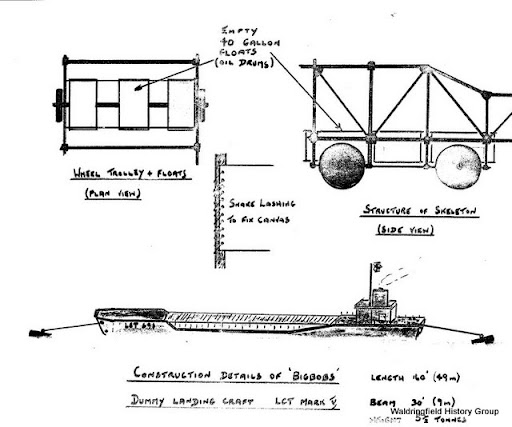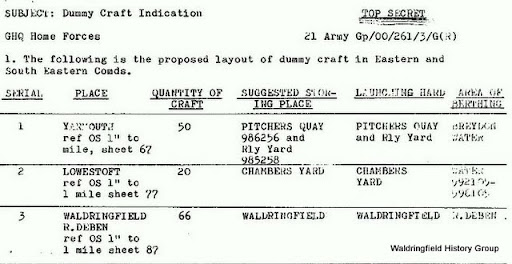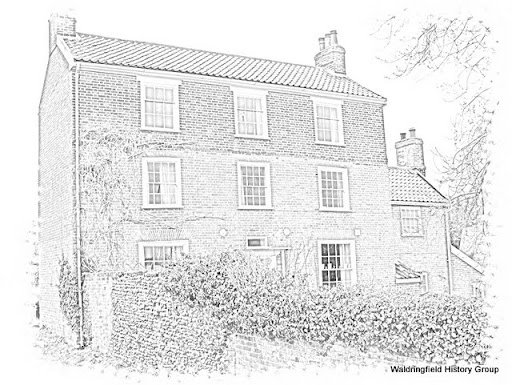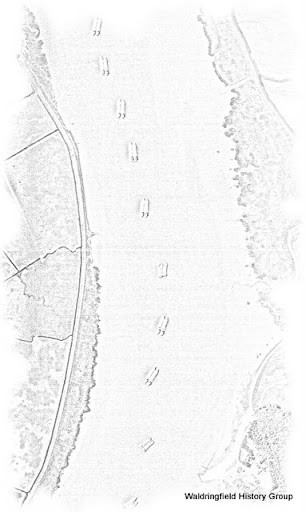Note:this article has been updated see Operation Big Bob
In World War Two the Allies wanted Nazi Germany to believe that the invasion of Europe would land at Calais and not Normandy. Consequently in early 1943 a grand deception plan was devised code named Operation Fortitude .
A small part of this plan was Operation Quicksilver . The idea was to position Dummy Landing Craft with fake army encampments in East Coast rivers from Yarmouth to Folkestone.

This would be consistent with the main invasion being at Calais. Surprisingly, for such a small village, Waldringfield played a central role in all this and the River Deben was a significant part of the ruse.
We know quite a lot about the plan partly from the memories of villagers but mainly through the book Operation Quicksilver written by the Royal Navy officer Peter Tooley who was part of the launching team. He took a river trip on the Jahan back in 1995 and was good enough, subsequently, to write to the Boatyard with some details of the operation and enclosed a copy of the Top Secret plans.
The deception plan was master-minded by Sir John Turner who was Director of Works at the Air Ministry. By late March 1943 work on the prototype had started and trials were underway on the South coast by July. The Royal Engineers felt the task did not need their skills and so the early versions were built by the Pioneer Corps although the Americans were involved at a later stage.
The specification called for a dummy craft that would be a lifelike replica of an LCT Mark IV (Landing Craft Tank), could be moored in estuaries in a force four wind and, most importantly, assembled in less than eight hours. These dummy Landing Craft were officially called device 36 but were known as Bigbobs . This was to distinguish them from the inflatable rubber dummy landing craft known as Wetbobs. Just like the real thing each Bigbob had a length of 160 feet and a beam of 30 feet. (roughly 50m by 9m). They weighed five and a half tons compared to the 400 ton displacement of the real LCT IV.

The engineering firm Cox s of Watford was engaged for production of the kits of parts and orders were placed in December 1943 for delivery in March 1944. The kits were manufactured with the cover story that they were mechanical elephants. Each kit was made up into a frame of 3 inch steel tubes which was assembled on top of empty oil drums for flotation. This was covered by lace up canvas sheets (that s a lot of canvas) and topped with a wooden wheelhouse.
Around 30 oil drums should be needed for floatation.
In all 266 Bigbobs had to be assembled and launched on the East Coast in about three weeks of Summer 1944 and therefore many men had to be trained how to build them.

Waldringfield was chosen as the training centre with the Maltings (the three storey house on the other side of Cliff Road to the Maybush) as Headquarters. The Officer in charge of training was Captain Allen of the Royal Engineers. Initially men from the Worcestershire and Northamptonshire regiments were trained with other units following.
The courses took place from February to March 1944 with 700 men being trained in all. Officers were billeted at Mrs Turner s Guest House, now Deben House and men at the Maltings and in Ipswich.

Extra beer rations were provided for the Maybush although Albert Hill, the publican at the time and for many years afterwards, was in Felixstowe as a Petty Officer at the MTB repair base.
A large construction area with access to the river was needed. Several beach huts were demolished or moved and the field called Sedge Close as well as what is now the beach dinghy park were used for assembly of the kits. The concrete walls in the area may have been constructed as part of this project.
Each Bigbob came as a 500 part kit and required a team of twenty men working overnight to assemble and launch before dawn using temporary wheels for moving them to the water. Three sub teams worked in parallel on the bow, middle stern and wooden wheelhouse sections. The design incorporated hinges so that as the structure was rolled down the slipway on steel wheels to the water the floating portion was able to float horizontally whilst the remainder rolled down the incline. At the water s edge responsibility transferred from the Army to the Royal Navy.
For the Navy positioning and mooring the Bigbobs must have been difficult as it had to be done rapidly, in darkness, regardless of wind and tide conditions and with no hull in the water they cannot have been easy to manoeuvre. The shallow water and sticky mud must have been very troublesome in the dark. There can also be quite tricky currents in that part of the river. If construction was not finished by first light the whole assembly had to be dismantled and hidden.
As the real invasion of Normandy approached draconian secrecy measures were imposed. A one mile wide exclusion zone was established from the Wash to Land s End and, of course, this included the whole of the village, additionally no civilian visits were allowed into a ten mile exclusion zone. Travel to Ireland was stopped, foreign diplomats were not allowed in or out of the U.K. and transatlantic telephone and radio communication was cut off.
The Deben, with 66 Bigbobs was to have the largest fleet after the Orwell with 70. The Waldringfield invasion fleet was built over nineteen days in May and June 1944. Traffic in village must have been heavy as to deliver four Bigbobs per day would require 28 three ton trucks in and out and this would have gone on for nearly three weeks. We have one aerial photograph which shows Bigbobs moored in pairs around Ramsholt. From measurements of the reconnaissance photograph it can be calculated that the fleet of 66 moored in pairs would have stretched over three miles.
Test aerial photographs had revealed that the Bigbobs looked to good to be true so they were painted with oil stains and rust to make them realistic. Once our 66 Bigbobs were moored in the Deben the White Ensign was flown every day, smoke was generated, laundry hung out and regular visits made by tenders to the skeleton crews on board. Anti Aircraft gunners were given orders to fire at visiting enemy reconnaissance planes but make very sure that they missed so that reconnaissance pictures would get back to Germany.

Operation Quicksilver was a complete success with captured records showing that they believed there to be 500 Landing Craft and 42 divisions in reserve whereas there were, in reality, only 15 divisions and no Landing Craft were available. On May 25th 1944, just before D-day on June 6th the German Commander in Chief, West still believed that the invasion would be between Dunkirk and Dieppe. Even on June 25th he believed that the Anglo American main force was uncommitted. The Germans did not move a division from the Calais area to Normandy until July 25th. Clearly this was a major contribution to the eventual defeat of the Nazis with Waldringfield and the River Deben playing their part.
Waldringfield History Group
September 2010




